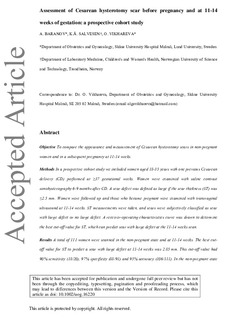Assessment of Cesarean hysterotomy scar before pregnancy and at 11-14 weeks of gestation: a prospective cohort study
Journal article, Peer reviewed
Accepted version
Permanent lenke
http://hdl.handle.net/11250/2493520Utgivelsesdato
2017Metadata
Vis full innførselSamlinger
Sammendrag
Objective
To compare the appearance and measurement of Cesarean hysterotomy scar before pregnancy and at 11–14 weeks in a subsequent pregnancy.
Methods
This was a prospective cohort study of women aged 18–35 years who had one previous Cesarean delivery (CD) at ≥ 37 weeks. Women were examined with saline contrast sonohysterography 6–9 months after CD. A scar defect was defined as large if scar thickness was ≤ 2.5 mm. Women were followed up and those who became pregnant were examined by transvaginal ultrasound at 11–14 weeks. Scar thickness was measured and scars were classified subjectively as a scar with or without a large defect. A receiver–operating characteristics curve was constructed to determine the best cut‐off value for scar thickness to define a large scar defect at the 11–14‐week scan.
Results
A total of 111 women with a previous CD were scanned in the non‐pregnant state and at 11–14 weeks in a subsequent pregnancy. The best cut‐off value for scar thickness to define a large scar defect at 11–14 weeks was 2.85 mm, which had 90% sensitivity (18/20), 97% specificity (88/91) and 95% accuracy (106/111). In the non‐pregnant state, large scar defects were found in 18 (16%) women and all were confirmed at the 11–14‐week scan. In addition, a large defect was found in three women at 11–14 weeks that was not identified in the non‐pregnant state.
Conclusion
The appearance of the Cesarean hysterotomy scar was similar in the non‐pregnant state and at 11–14 weeks in a subsequent pregnancy.
